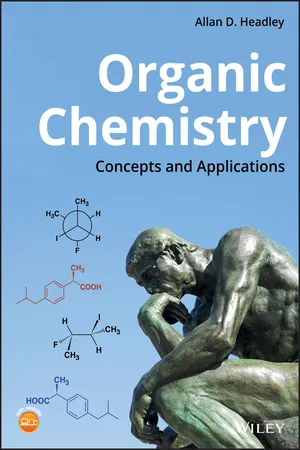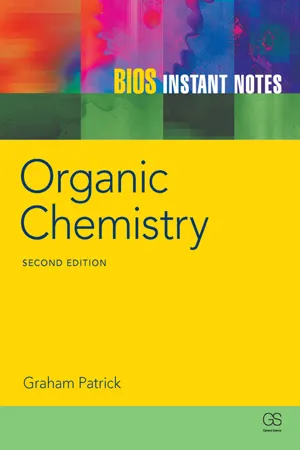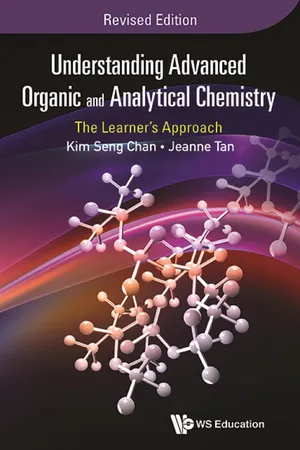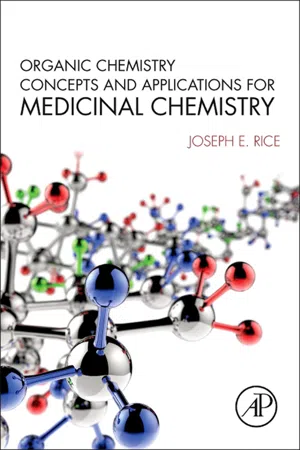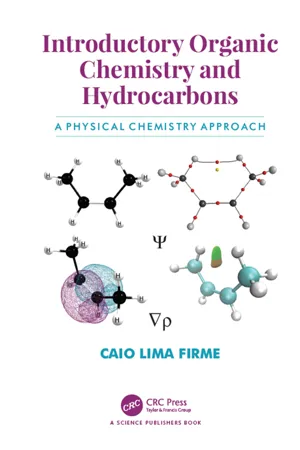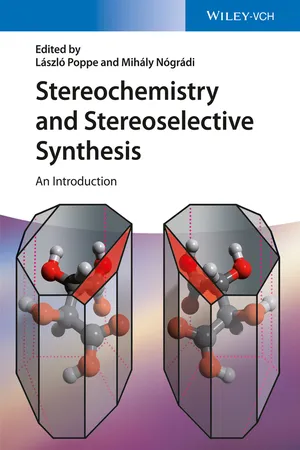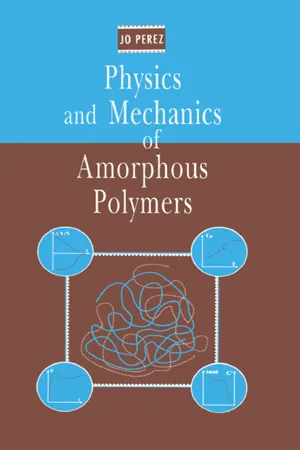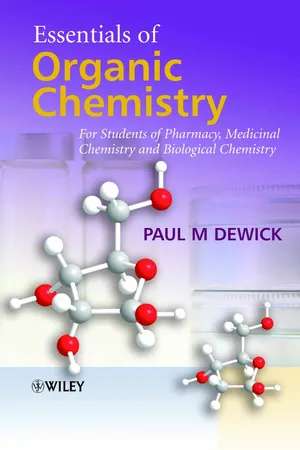Chemistry
Conformational Isomers
Conformational isomers are different spatial arrangements of the same molecule, resulting from rotation around single bonds. These isomers have the same chemical structure but differ in the orientation of atoms in space. They are important in understanding the behavior of molecules, especially in the fields of organic and biochemistry.
Written by Perlego with AI-assistance
Related key terms
Related key terms
1 of 4
Related key terms
1 of 3
12 Key excerpts on "Conformational Isomers"
- eBook - ePub
Organic Chemistry
Concepts and Applications
- Allan D. Headley(Author)
- 2019(Publication Date)
- Wiley(Publisher)
constitutional isomers. Since structural isomers are different compounds, they have different properties, such as density and melting points.Problem 4.1
- Give structural formulas for all possible structural isomers of C5 H12 .
- Give IUPAC names for the isomers of question (i) above.
4.3 Conformational Isomers of Alkanes
At room temperature, rotation about a carbon–carbon single bond of molecules occurs freely. For some molecules that have bulky groups bonded to adjacent carbons of a carbon–carbon single covalent bond, rotation is a bit more difficult compared to molecules that have smaller groups bonded to similar adjacent carbon atoms. Owing to the restricted rotation that results around the carbon–carbon bond of such a molecule that has bulky groups, the bulky groups spend more time in specific regions of the molecule, typically as far away as possible from each other, compared to being closer to each other resulting in different conformations of the molecules. The terms conformers and rotamers are used to describe these types of isomers. By definition, conformers are isomers with the same atom connectivity but have different arrangements of specific groups about a single bond, which comes about due to rotation about a carbon–carbon single bond. The term isomeric conformer is used to describe conformers in which groups around a carbon–carbon single bond are in different locations. The illustration of this three‐dimensional concept on two‐dimensional paper can be challenging and specific representations must be used to convey the orientation of the different Conformational Isomers. There are two types of representations that are typically used to represent conformers in organic chemistry: dashed/wedge and the Newman projection - eBook - ePub
Chemistry for Pharmacy Students
General, Organic and Natural Product Chemistry
- Lutfun Nahar, Professor Satyajit D. Sarker(Authors)
- 2019(Publication Date)
- Wiley(Publisher)
trans‐cinnamic acid only differ in the three dimensional orientation of the atoms or groups.There are two major types of stereoisomers: Conformational Isomers and configurational isomers. Configurational isomers include optical isomers, geometrical isomers, enantiomers and diastereomers.3.2.2.1 Conformational Isomers
Atoms within a molecule move relative to one another by the rotation around covalent single bonds (σ bonds) and the 3D tetrahedral shape of the sp 3 ‐hybridized centres. Such rotation of covalent bonds gives rise to different conformations of a compound. Conformers may also result from restricted rotations in rings. The number of different conformers depends on the number of single bonds and on the number and size of the flexible rings. Each structure is called a conformer or conformational isomer.Generally, conformers rapidly interconvert at room temperature.cssStyle="font-style:italic;" 3.2.2.1.1 Conformational Isomers of Alkanes
Conformational isomerism can be presented with the simplest example, ethane (C2 H6 ), which can exist as an infinite number of conformers by the rotation of C─C σ bond. Ethane has two sp 3 ‐hybridized carbon atoms and the tetrahedral angle about each is 109.5°. The most significant conformers of ethane are the staggered and eclipsed conformers. The staggered conformation is the most stable as it is of the lowest energy.cssStyle="font-style:italic;" 3.2.2.1.2 Visualization of Conformers
There are four conventional methods for visualization of 3D structures on paper, that is, the ball and stick method, sawhorse method, wedge and broken line method and Newman projection method. Using these methods, the staggered and eclipsed conformers of ethane can be drawn as follows. - eBook - ePub
Conformational Concept For Synthetic Chemist's Use: Principles And In Lab Exploitation
Principles and in Lab Exploitation
- Anatoly M Belostotskii(Author)
- 2015(Publication Date)
- WSPC(Publisher)
conformation is very near the broad conformational approach, and takes more and more room in research practice of organic chemists.This description of flexible molecular shape covers all possible stereorearrangements in organic molecules. In defining the conformational relationship, it does not require auxiliary stereochemical descriptors (symmetry operations) for 3D structures or any limits for kinetic barriers of their interconversion. As indicated, it does not specify certain intramolecular motions, conferring upon them the status of conformational transformations. For example, similarly to the kinetic barrier approach, all stereoisomeric structures of piperidine 14b shown in Fig. 37 are considered as conformationally related. Opposite configurations of the nitrogen do not disturb this convenient ranking of all stable stereoisomers of cycle 14b as conformers.Organic chemists are used to assessing conformer (also stereoisomer) as a single, case-specific, 3D molecular backbone. However, many molecules (understood as a statistical molecular ensemble) of the same stereoisomer cannot be characterized by a single 3D geometry. Molecular vibrational energy has a noticeable impact on molecular geometry, and this energy is different for molecules of the ensemble. Note that the vibrational energy cannot be fully taken out of molecules even at 0 K.In order to understand this non-trivial stereochemical aspect, we should consider an abstract adiabatic minimum of energy for the ground electronic state of a molecule. Recall the “topography” of this minimum. For real systems, the potential well is non-symmetrical, but, for the sake of simplicity, we can approximate it with a symmetrical well of parabolic form (Fig. 42 ); the abscissa (coordinate r) indicates the molecular geometry, and the ordinate (coordinate energy) shows potential (i.e., non-kinetic) energy of the molecule. The r0 value corresponds to the so-called equilibrium geometry, i.e., the geometry that is characterized by the minimal energy value of the energy well. Any energy minimum in the PES (Section 3.1) has vibrational and rotational levels of energy; their number is infinite. Only the levels can be populated, i.e., energy cannot have a value that is “between levels.”a The allowed values for vibration energy are ν0 , ν1 , ν2 ,..., νi - eBook - ePub
- Graham Patrick(Author)
- 2004(Publication Date)
- Taylor & Francis(Publisher)
SECTION D — STEREOCHEMISTRYD1 Constitutional isomers
Key Notes
Introduction Isomers are compounds which have the same molecular formula, but differ in the way the atoms are arranged. There are three types of isomers — constitutional, configurational, and conformational. Definition Constitutional isomers are compounds which have the same molecular formula but have the atoms joined together in a different way. Constitutional isomers have different physical and chemical properties. Alkanes Alkanes of a particular molecular formula can have various constitutional isomers. The larger the alkane, the more isomers are possible. Related topics (B3) Nomenclature (C5) Nomenclature of functional groups (D2) Configurational isomers -alkenes and cycloalkanes (D3) Configurational isomers -optical isomers (D4) Conformational Isomers Introduction
Isomers are compounds which have the same molecular formula (i.e. they have the same atoms), but differ in the way these atoms are arranged. There are three types of isomers — constitutional isomers, configurational isomers, and Conformational Isomers. Constitutional isomers are isomers where the atoms are linked together in a different skeletal framework and are different compounds. Configurational isomers are structures having the same atoms and bonds, but which have different geometrical shapes that cannot be interconverted without breaking covalent bonds. Configurational isomers can be separated and have different properties. Conformational Isomers are different shapes of the same molecule and cannot be separated.Definition
Constitutional isomers are compounds which have the same molecular formula but have the atoms joined together in a different way. In other words, they have different carbon skeletons. Constitutional isomers have different physical and chemical properties.Alkanes
Alkanes of a particular molecular formula can exist as different constitutional isomers. For example, the alkane having the molecular formula C4 H10 can exist as two constitutional isomers — the straight chain alkane (butane) or the branched alkane (2-methylpropane; Figure 1 - eBook - ePub
DAT Prep Plus 2023-2024
2 Practice Tests + Proven Strategies + Online
- (Author)
- 2023(Publication Date)
- Kaplan Test Prep(Publisher)
meso-tartaric acid has two chiral carbon atoms, the lack of optical activity is a function of the molecule as a whole.Conformational Isomers
Conformational Isomers are compounds that differ only by rotation about one or more single bonds. These isomers represent the same compound in a slightly different position—analogous to a person who may be either standing up or sitting down. These different conformations can be seen when the molecule is depicted in a Newman projection, in which the line of sight extends along a carbon-carbon bond axis. Because the view of the second carbon atom is blocked by the first, the second carbon is depicted as a large circle at the back, and the first carbon is depicted as the intersection of its three other bonds in front. The different conformations are encountered as the molecule is rotated about the axis between the two carbons. The classic example for demonstrating conformational isomerism in a straight chain molecule is n-butane. In a Newman projection, the line of sight extends through the C−2-C−3 bond axis.Figure 40.13Straight-chain conformations
The most stable conformation of n-butane is found when the two methyl groups (C–1 and C–4) are oriented 180° from each other. There is no overlap of atoms along the line of sight (besides C–2 and C–3), so the molecule is said to be in a staggered conformation. Specifically, it is called the anti conformation, because the two methyl groups are antiperiplanar to each other. This particular orientation is very stable and thus represents an energy minimum because all atoms are far apart, minimizing repulsive steric interactions.The other type of staggered conformation, called gauche, occurs when the two methyl groups are 60° apart. In order to convert from the anti to the gauche - eBook - ePub
Understanding Advanced Organic and Analytical Chemistry
The Learner's ApproachRevised Edition
- Kim Seng Chan, Jeanne Tan;;;(Authors)
- 2016(Publication Date)
- WS EDUCATION(Publisher)
Take, for instance, cyclopropane. For a carbon atom bonded to four substituents, repulsion between electron clouds is minimal at bond angles of 109.5° (as in a tetrahedral configuration). But when three of such carbon atoms are forced together into a ring, the C–C bond angles are acute and are less than the ideal 109.5° (What is the internal angle of an equilateral triangle?). In order to assume the triangular ring structure, the orbitals of two adjacent carbon atoms would not be able to overlap exactly head-on with each other to form the sigma bond. In chemical bonding terms, we say that the overlap is less effective. Consequently, the bond energy is less endothermic, indicating a weaker bond strength.Even when we talk about saturated alkanes such as ethane, rotation about a single bond is not smooth sailing.2.3.2 Conformational Isomerism
Conformational isomerism is best understood when one acquires the skill of visualising the spatial orientation of groups of atoms around a central carbon atom using the Newman projection method. In this scheme, the spatial orientation of substituents about a carbon– carbon bond is visualized from the front-to-end view about this bond. Take ethane, for instance. Its Newman projection has C1 depicted as a point of intersection of three C–H bonds, and C2 is represented by the circle at the rear (see Fig. 2.1 ).Rotating only one of the C atoms of the carbon–carbon bond will bring the H substituents into different spatial orientation and hence different proximity to one another. On the left side of Fig. 2.1 is the staggered conformation and on the right, the eclipsed conformation. There are other intermediate conformations between these two, but our attention centers on the staggered and eclipsed conformations. These different but specific spatial orientations, obtained through rotation about a single bond, represent what is known as Conformational Isomers. The Newman projection is one approach for illustrating such isomers. Another approach is the Sawhorse representation, as shown in Fig. 2.1 .Fig. 2.1.Notice that the H atoms on both C atoms are much closer together in the eclipsed conformation? The inter-electronic repulsions between these H atoms are the greatest due to their close proximity. This structure is in a “tension” state and has a higher energy state than the staggered conformation. The staggered conformation is thus more stable than the eclipsed conformation, as shown in Fig. 2.2 - eBook - ePub
Carbohydrate Chemistry
Fundamentals and Applications
- Raimo Alén(Author)
- 2018(Publication Date)
- WSPC(Publisher)
Fig. 3.1. The main types of isomerism and their subtypes.The branch of organic chemistry that examines the three-dimensional structures of molecules,stereochemistry, has gained importance when striving to understand the physical and chemical properties of various compounds. In carbohydrate chemistry, it is also essential to know the stereochemical structure of the compounds. Stereoisomerism can be seen to generally represent the form of isomerism where compounds with the same chemical structure (i.e., the order of attachment of the atoms involved and the location of the bonds between them) differ from each other only in the spatial direction of their atoms or atom groups. This isomerism is divided into (i)optical isomerism(“physical isomerism”), (ii)conformational isomerism, and (iii)geometric isomerism(“cis/transisomerism”). As the first two types are characteristic of carbohydrates, they will be emphasized in the following discussion.3.2.Constitutional Isomerism
Constitutional isomers generally differ from one another only in the order of attachment of their atoms and the location of their bonds. In the functional group isomerism, the isomers have the same molecular formula, but their functional groups are different. The following compounds are examples of such isomers:Chain isomers have the same molecular formula, but the skeleton (usually carbon skeleton) differs by having branches or otherwise. The following compounds (C5 H12 ) are examples:The number of chain isomers increases very rapidly with the increase in the number of carbon atoms in the compound. Theoretically, for 6, 7, 8, 15, and 20 carbon atoms in an aliphatic hydrocarbon, the numbers of possible chain isomers are 5, 9, 18, 4347, and 366,319, respectively. - Joseph E. Rice(Author)
- 2014(Publication Date)
- Academic Press(Publisher)
Chapter 2The Three-Dimensional Structure of Organic Compounds
Abstract
This chapter opens with a discussion of the various types of isomers leading into a more detailed look at stereoisomerism. The concept of optical isomers at saturated asymmetric centers is then introduced along with a discussion of the properties of enantiomers and the methods used to designate absolute configuration at such stereocenters. Diastereomers are then discussed as being stereoisomers that are not enantiomers. The idea of prochirality is introduced and examples of saturated prochiral centers and unsaturated prochiral faces are given. Stereoisomerism at unsaturated centers is then discussed along with a system to designate those isomers. The last section deals with conformations, beginning first with acyclic systems and then progressing to cyclohexanes, and finally to five-, four-, and three-membered saturated rings.Keywords
Absolute configuration ; Chiral center ; Conformation ; Diastereomer ; Dihedral angle ; Eclipsed ; Enantiomer ; Isomer ; Nonbonded interactions ; ProchiralOne of the critical factors associated with drug–receptor interactions is the three-dimensional structure of both the drug and receptor molecules. Efficient interaction between a drug and its receptor depends not only on the absolute and relative positioning of groups in space but also on the ability of the molecule to modify its shape by rotating about single bonds. These aspects of chemical structure are known as stereochemistry and conformation and are the topics covered in this chapter.Isomers
Two or more compounds that have the same empirical formula but differ with respect to how the various atoms are joined are called isomers . Isomers are broken down into two broad categories. The first is constitutional isomers —compounds that differ in constitution or make-up. Thus cyclopropane and propylene (Figure 2.1 ) are constitutional isomers because cyclopropane is composed of three CH2 (methylene) groups arranged into a three-membered ring, whereas propylene is acyclic with a vinyl and a methyl group. The alcohols n -propanol and i -propanol are also constitutional isomers that are similar chemically but differ in the position to which the hydroxyl group is attached (also called positional isomers ). Thus n -propanol has the hydroxyl group attached to methylene with an ethyl group attached to the same carbon. In contrast, i -propanol has the OH group attached to a CH (methine) that is also attached to two methyl groups. Another example of this is seen with isobutylene and cis - or trans -2-butene. Isobutylene has one sp2 -hybridized carbon with two methyl groups and another one with two hydrogen atoms attached, whereas cis - and trans -2-butene have two sp2 carbons each with one methyl group and one hydrogen atom. Thus, isobutylene and cis - or trans -2-butene are constitutional isomers. But what is the relationship between cis - and trans -2-butene? Since they have the same constitution but differ in the special arrangement of the various groups, they are called stereoisomers- eBook - ePub
Introductory Organic Chemistry and Hydrocarbons
A Physical Chemistry Approach
- Caio Lima Firme(Author)
- 2019(Publication Date)
- CRC Press(Publisher)
Chapter ThirteenIsomerism
ISOMERISM AND TYPES OF ISOMERISM
Isomerism gives rise to isomers that are molecules with the same chemical formula but different structural parameters or different spacial structures (different type of branching or different type of functional group or different position of the same functional group or different arrangement of substituents or different absolute configuration of the asymmetric atom).As for structural isomerism, there are three types: chain isomerism, position isomerism (or regioisomerism), and functional isomerism.The chain isomerism is related to the different position of the branching in its main chain. For example, butane and 2-methyl-propane are isomers (C4 H10 ); pentane, 2-methyl-butane and 2,2-dimethyl-propane are isomers (C5 H12 ); but-1-ene and 2-methyl propene are isomers (C4 H8 ) as well (see Fig. 13.1(A) ).Figure 13.1 Bond line formula of (A) chain isomers, (B) regioisomers, and (C) functional isomers.The position isomerism (or regioisomerism) is related to a different position of the substituent group or functional group in the molecule. For example, but-1-ene and but-2-ene are isomers (C4 H8 ), pentan-2-one and pentan-3-one are isomers (C5 H10 O), 2-chloro-propane and 1-chloro-propane are isomers (C3 H7 Cl), orto-dichlorobenzene and para-dichlorobenzene are isomers (C6 H4 Cl2 ) as well (see Fig. 13.1(B) ).Functional isomerism is related to different functional groups with the same molecular formula. For example, propanone and propanal are isomers (C3 H6 O), hexan-1-ene and cyclohexane (C6 H12 ) are isomers as well (see Fig. 13.1(C) ).Stereoisomerism is related to specific arrangements of substituents where two isomers are differentiated by their spacial disposition. Stereo means spacial.GEOMETRIC STEREOISOMERISM
Geometric stereoisomerm occurs in alkenes or derivatives and in substituted cycloalkanes. They generate two isomers called cis and trans or E and Z. - eBook - ePub
Stereochemistry and Stereoselective Synthesis
An Introduction
- Mihály Nógrádi, László Poppe, József Nagy, Gábor Hornyánszky, Zoltán Boros(Authors)
- 2016(Publication Date)
- Wiley-VCH(Publisher)
Section 2.3.4 , dealing with axial chirality, we have discussed that the presence of four different ligands (A, B, C, and D) is not a necessary condition for axial chirality including atropisomerism; it is sufficient when coplanar pairs of ligands (A, B and C, D, respectively) are different. Because the atropisomers are in nonidentical mirror image relationship, they are enantiomers.Since atropisomerism may be due to hindered rotation around a single bond, it is not restricted to biphenyls (Figure 3.6 ).Atropisomerism of compounds differing from biphenyls.Figure 3.6Hindered rotation around a single bond within various other compounds such as 2,2′-substituted-1,1′-binaphthalenes (I), 1-(o-substituted-phenyl)-2,5-disubstituted-1H-pyrroles (II), or N,N-disubstituted-2-substituted-1-naphthamides (III) may also result in atropisomers.References
- 1. Moss, G.P. and International Union of Pure and Applied Chemistry, Organic Chemistry Division, Commission on Nomenclature of Organic Chemistry [III. 1] and Commission on Physical Organic Chemistry [III.2] (1996) Basic Terminology of Stereochemistry (IUPAC Recommendations 1996). Pure. Appl. Chem., 68 (12), 2193–2222.
- 2. McNaught, A.D. and Wilkinson, A. (1997) Compendium of Chemical Terminology, 2nd edn, Blackwell Science, Oxford [ISBN 0-86542-6848].
- 3. IUPAC (2014) Compendium of Chemical Terminology: Gold Book, Version 2.3.3, http://goldbook.iupac.org/PDF/goldbook.pdf (accessed 17 January 2016).
1 According to IUPAC recommendations [1–3] “a conformer is one among those stereoisomers, which can be characterized by a conformation associated with a defined potential energy minimum.” Since the definition of conformer is not unambiguous and sometimes this very concept is used to denote potential energy maxima, in this work we avoided it and all conformational states were called conformations.2 These values are depending on the state of the material. Energy difference between individual conformations is larger in gas phase than in liquid phase. Accordingly, in a liquid phase, the ap state is present in 56%, while the sc - eBook - ePub
- Jo Perez(Author)
- 2018(Publication Date)
- CRC Press(Publisher)
The second is relative to the existence of isomers from structural units having a double bond; the possibility of rotation around the axis joining the concerned carbons then does not occur. This results in isomers of different geometry. The classical example is that of polyisoprene:Finally, we must consider the tacticity: polymers may be isotactic (the structural units R are always found on the same side of the chain), syndiotactic (structural units alternate regularly on both sides of the chain) and atactic (structural units randomly distributed on one or the other side of the chain). As a general rule, it may be said that the tendency to crystallise and the type of crystalline ordering depend on the configuration of the repeat unit; thus the amorphous polymers described herein are often atactic.1.3 Conformation of MacromoleculesLet us recall that the hybrid orbitals around carbon enable us to describe a sequence of these atoms bonded by covalent bonds such as a tetrahedral sequence bonded by its peaks. Figure I.1 shows the simplest case, that of the ‘ethane’ molecule. That a rotational degree of freedom exists between one tetrahedron with respect to the other is very clear. However, all the positions are not equally probable: Figure I.1(c) indicates the variation of energy of this molecule with the angle of rotation θ. The effects of interactions between hydrogens are minimised for θ = 60, 180 and 300°, these three positions being equally probable.Fig. I.1. Rotational degrees of freedom of ‘ethane’ molecule and energy profile.The situation is different for the ‘butane’ molecule. Figure I.2 shows that only one stable position exists: θ = 180°; the other two minima (θ = 60° and 300°) correspond to metastable states. The conformation is called trans in the first case and respectively gauche (+) and gauche (−) in the other two. The same situation is found in the sequence i, i + 3 of 4 successive carbons of a macromolecular chain. Figure I.2(c) indicates the possibility of rotation of carbon i + 4 and Figure I.2(b) variation of the energy of this sequence as a function of θ. It is necessary to distinguish the difference in level of energy ΔE1 and height of the barrier ΔE2 to be jumped in order to pass from trans to gauche conformations; ΔE1 - eBook - ePub
Essentials of Organic Chemistry
For Students of Pharmacy, Medicinal Chemistry and Biological Chemistry
- Paul M. Dewick(Author)
- 2013(Publication Date)
- Wiley(Publisher)
Thus, there are two chiral centres, and the groups around each centre are the same. Again, we get only three stereoisomers rather than four, since the cis compound is an optically inactive meso compound. There is a plane of symmetry in this molecule, and it is easy to see that one chiral centre is mirrored by the other, so that we lose optical activity. Conformational mobility, such as we get in cyclohexane rings, makes the analysis more difficult, and manipulating molecular models provides the clearest vision of the relationships. Let us look at 1,2-dimethylcyclohexane as an example. Again, we have met the cis and trans isomers when we looked at conformational aspects (see Section 3.3.2). Here, we need to consider both configuration and conformation. In the trans compound, two mirror image enantiomeric forms can be visualized. These will be the (+)- and (−)- trans isomers. Note particularly that conformational changes may also be considered, but these do not change configuration, so we are only seeing different conformers of the same compound. The above scheme thus shows two interconvertible conformers (upper and lower structures) for each of the two non-interconvertible enantiomers (left and right structures). The cis compound provides the real challenge, however. If we draw version A, together with its mirror image C, they do not look capable of being superimposed. However, conformer A may be ring-flipped to an equal-energy conformer B, and this will have a corresponding mirror image version D. Now consider a 120° rotation of version A about the central axis; this will give D. A similar 120° rotation of version C about the central axis will give B. It follows, therefore, that if simple rotation of one structure about its axis gives the mirror image of a conformational isomer, then we cannot have enantiomeric forms but must have the same compound. These are thus two different conformers of an optically inactive meso compound
Index pages curate the most relevant extracts from our library of academic textbooks. They’ve been created using an in-house natural language model (NLM), each adding context and meaning to key research topics.
Explore more topic indexes
Explore more topic indexes
1 of 6
Explore more topic indexes
1 of 4
